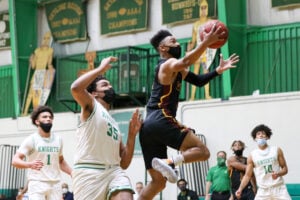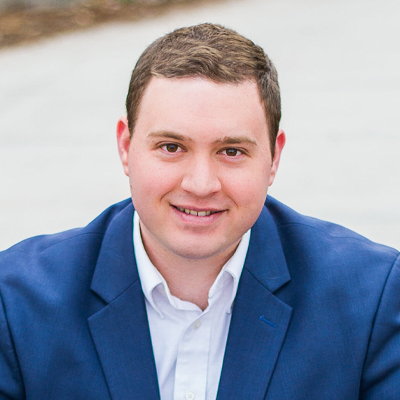
Arizona high schools could be using a shot clock for basketball games in the future after the National Federation of State High School Associations announced a new shot clock adoption option in May. (Photo by Alex Menendez/Getty Images)
PHOENIX — Most youth who have played basketball at the park or in their driveway have likely done this: pretended to hit a high-stakes shot as the buzzer sounds. That could happen more often during Arizona high school basketball games if the state moves forward with a 35-second shot clock.
The National Federation of State High School Associations announced a new shot clock adoption option in May after eight states, including California, Washington state, and New York, completed an entire season testing the clock. Data and information gathered from these states through surveys were provided to the NFHS, which led to its decision. The adoption option allows state high school associations to choose whether they want to implement a shot clock as early as the 2022-2023 season.
Karrisa Niehoff, executive director of the NFHS, said the initial vote by the rules committee was 11 to 1 to allow the adoption option.
NFHS rules, historically, forbid states from using shot clocks at the high school level, and if schools did, state associations forfeit their seat on the rules committee. Now, state associations will remain on the committee regardless of what option they decide.
Since Arizona was not one of the eight states previously testing a shot clock, the Arizona Interscholastic Association plans to build from preliminary data, and do a thorough gathering of data in the next year which will be used to decide whether to add the clock as early as the 2022-2023 season.
Joe Paddock, assistant director of the AIA, said the association will look to its schools, athletic directors and coaches for insight.
“If the schools are in favor of it, you know, certainly we’re going to support our schools as we do and we’ll get the shot clock implemented,” Paddock said.
With help from Monarch Sports Arizona, a sports events-management company in Phoenix, the AIA started preliminary research on implementing a shot clock in the Visit Mesa Challenge during the 2018-19 season. The four-day event held at Mesa Mountain View High School featured 16 schools, a few from out of state and local schools like Sunnyslope, Chaparral, Rancho Solano and Corona del Sol.
Corona del Sol coach Neil MacDonald said adding a shot clock at the high school level is a logical move.
“I’m for it, absolutely,” MacDonald said. “I think we need to catch up with the rest of the basketball world. … Obviously college and pros play with a shot clock so I think that it makes sense for us to do that.”
MacDonald said a shot clock could create more exciting games and force coaches and players to better strategize during the final minutes of games. He said during those minutes a team that’s winning by a few points could simply keep the ball away from their opponent until the game ends if there is no shot clock. However, adding a shot clock forces teams to play quicker and opportunities to waste time are limited.
Brian Gessner, state commissioner of officials for the AIA, led the research team collecting data from the tournament.
“I don’t think we need it in high school for a number of various reasons,” Gessner said. “It’s going to have very little effect. I don’t share the same opinion of the coaches.”
Gessner, who was a basketball official for 30 years in Arizona, also sits on the NFHS basketball rules committee. During the Visit Mesa Challenge he looked at how the shot clock impacted the game from a logistical standpoint for schools, officials, coaches and players.
“We have literally, certainly tens of thousands of plays if not hundreds of thousands of plays of data collected by the NFHS and the average possession time is 15.8 seconds of possession,” Gessner said.
By using less than half the allotted time a shot clock offers, Gessner said, “it’s a shiny new toy,” and in the end, smaller, less talented teams could suffer.
“By putting in a shot clock I think what you’re going to find is superior, talented teams are just going to destroy the lesser talented teams,” Gessner said.
One concern that came through the surveys was how it will affect developing players.
“What we have heard up to this point was a concern that especially at developmental levels, perhaps a freshman, JV level, a shot clock would infuse a sense of urgency that might impact execution on the court,” Niehoff said.
MacDonald said he doesn’t think adding a shot clock will be tough for young players. Instead, it’s a way for them to develop and learn skills early on.
“You’re going to expect a younger freshman and JV team to have areas of struggle no matter what,” MacDonald said. “I would say that if you’re going to play with a shot clock at the varsity level, you would need to play with it at the JV and freshman level. You’ve got to give them the opportunity to play in the same environment that they would play in at the varsity level.”

Many high school coaches in Arizona are in support of adding a shot clock to high school games. Corona del Sol boys basketball coach Neil MacDonald believes adding one is a logical move. (File photo by Alina Nelson/Cronkite News)
MacDonald said coaches are already preparing players to set their offense quickly.
“If a younger group is struggling getting into the offense, just because you didn’t have a shot clock doesn’t mean you wouldn’t work on it anyway,” MacDonald said. “That should be something that you’re already working on.”
Paddock said coaches seem to favor the shot clock, while athletic directors are split 50-50.
Paddock said one reason for that “50-50 split” is the logistics of adding a shot clock. The adoption rule requires two devices with a separate horn attached to a different device from the game clock. Adding a shot clock would also mean paying for and installing it and in many cases staff would need to be hired and trained. Referees would also need to be trained on how to officiate with the shot clock. Paddock said the AIA doesn’t have a solid number yet on how much it would cost but Gessner estimates the total cost to be between $2,000 and $5,000 per shot clock.
Paddock said many of the larger schools in the Valley have expressed a desire for a shot clock. The NFHS adoption option will allow each state to create guidelines and specific rules for the addition of a shot clock. For example, perhaps larger schools begin using a shot clock while smaller ones do not. Boys and girls teams could also take a different approach. Paddock said these types of choices will be decided by the AIA after more information is gathered.
Many states have pushed for a national rule for a shot clock at the high school level. However, Niehoff said going from no shot clock to a national rule is a big jump.
“The idea is to give states the opportunity to implement it if they really think it’s important and have the means to do it,” Niehoff said. “If we make it a national rule that you must use a shot clock, all of a sudden there are philosophical things that might be challenging. There is necessitation of equipment, training, staffing and some things that some state associations might not be ready to do.”
Niehoff said the NFHS is a “member driven organization” and all new or changed rules come initially from the members and then go through multiple committees for approval. In this process, state associations, athletic directors, officials and coaches are able to submit proposals for changes or new rule suggestions. Then a vote is taken by the NFHS Rules Committee, another committee called the Rules Review Committee, and finally by the Board of Directors.
“Will the membership go in a national shot clock as a rule direction? Who knows,” Niehoff said. “Because this is such a divisive issue historically, this is pretty significant that it reached the state adoption option level.”
